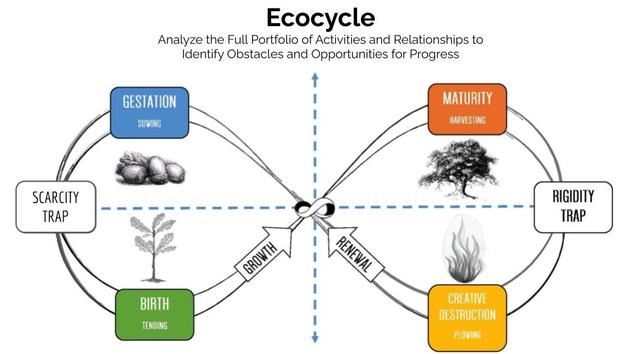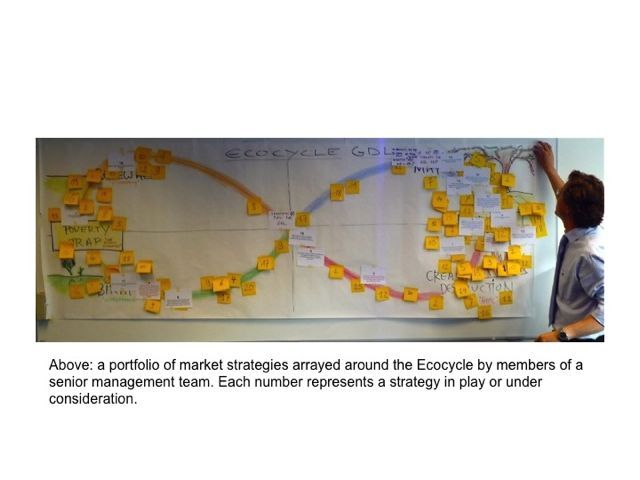![]() Ecocycle Planning
Ecocycle Planning
Analyze the Full Portfolio of Activities and Relationships to Identify Obstacles and Opportunities for Progress (95 min.)
What is made possible? You can eliminate or mitigate common bottlenecks that stifle performance by sifting your group’s portfolio of activities, identifying which elements are starving for resources and which ones are rigid and hampering progress. The Ecocycle makes it possible to sift, prioritize, and plan actions with everyone involved in the activities at the same time, as opposed to the conventional way of doing it behind closed doors with a small group of people. Additionally, the Ecocycle helps everyone see the forest AND the trees—they see where their activities fit in the larger context with others. Ecocycle Planning invites leaders to focus also on creative destruction and renewal in addition to typical themes regarding growth or efficiency. The Ecocycle makes it possible to spur agility, resilience, and sustained performance by including all four phases of development in the planning process.
Below: Presentation material we use to introduce Ecocycle Planning

Five Structural Elements – Min Specs
1. Structuring Invitation
- Invite the group to view, organize, and prioritize current activities using four developmental phases: birth, maturity, creative destruction, and renewal
- Invite the group to formulate action steps linked to each phase: actions that accelerate growth during the birth phase, actions that extend life or increase efficiency during the maturity phase, actions that prune dead wood or compost rigid practices during the creative destruction phase, actions that connect creative people or prepare the ground for birth during the renewal phase. The leadership stance required for each phase can be characterized as entrepreneur, manager, heretic, and networker.
2. How Space Is Arranged and Materials Needed
- A room with an open flat wall and open space for participants to stand comfortably in front of the wall
- Chairs for people to sit in groups of 4, with or without small round tables
- A blank Ecocycle map worksheet for each participant and a large wall-poster version posted on the wall
- Post-it notes for each activity
3. How Participation Is Distributed
- Everybody involved in the work is included, all levels and functions
- Everyone has an equal opportunity to contribute
4. How Groups Are Configured
- 1-2-4-All
- Small groups for action steps
5. Sequence of Steps and Time Allocation
- Introduce the idea of the Ecocycle and hand out a blank map to each participant. 5 min.
- Ask participants to generate their individual activity lists: “For your working group (e.g., department, function, or whole company), make a list of all the activities (projects, initiatives) that occupy your time.” 5 min.
- Ask them to work in pairs to decide the placement of every activity in the Ecocycle. 10 min.
- Invite them to form groups of four and finalize the placement of activities on the Ecocycle map. 15 min.
- Ask each group to put its activities on Post-it notes and create a whole-room map by inviting the groups one by one to place their Post-its on the larger map. 15 min.
- Ask each group to step back and digest the pattern of placements. Ask them to focus on all the activities on which there is consensus about their placement. Ask, “What activities do we need to creatively destroy or stop to move forward? What activities do we need to expand or start to move forward?” 15 min.
- In small groups, for each activity that needs to be stopped (activities that are in the Rigidity Trap), create a first-action step. 10 min. or more depending on the number of activities and groups.
- In small groups, for each activity that needs to start or get more resources (activities in the Scarcity trap), create a first-action step. 10 min. or more as above.
- Ask all the groups to focus on all the activities for which there is no consensus. Do a quick round of conversation to make sense of the differences in placement. When possible, create first-action steps to handle each one. 10 min.
WHY? Purposes
- Set priorities
- Balance a portfolio of strategies
- Identify waste and opportunities to free up resources
- Bring and hear all perspectives at once
- Create resilience and absorb disruptions by reorganizing programs together
- To reveal the whole picture, the forest AND the trees
Tips and Traps
- Don’t do your first Ecocycle Planning session with your group’s entire portfolio of market strategies. Start with a simpler program, something tangible with shared experience.
- Remind participants that all phases of the Ecocycle must be parts of a healthy organization
- Be very clear on the domain or type of activities being considered—check activities to be sure they are on a similar scale and domain
- Include views from inside and outside the organization or function (diverse participants and clients can help)
- Preparations and explicit criteria for each quadrant may help or interfere
- Don’t hesitate to do a second round
- Identifying the Rigidity and Scarcity Traps, plus connecting specific activities with these labels, launches the search for solutions
- Learn more from professor Brenda Zimmerman at Change-Ability and see the excerpt from her book Edgeware under the tab Publications
Riffs and Variations
- Ask participants to make a list of all their important relationships with internal and external customers/suppliers (in addition to their activities) and to place them on the Ecocycle. Ask them to evaluate the relationships with the same questions used for the activities and to include them in the last four steps of the Ecocycle planning process. Highly recommended!
- String together with Panarchy, 1-2-4-All, WINFY, and Open Space
- TRIZ can help to deepen the Creative Destruction quadrant
- Use with virtual groups by inviting participants to place their Ecocycle assessments with a dot on the whiteboard, then chat in pairs and with the whole group about the pattern that emerges. Before you enter into full-group placements, use silence and paired chat (1-2-All) to build understanding. You will need to agree on a short common list of activities or relationships to help simplify mapping. Number or letter each item and invite placements one by one. Sift and sort answers with a whiteboard and a person playing a “synthesizer” role. Don’t worry about perfection in the first rounds. Virtual sessions can deepen or complement face-to-face exchanges.
- What, So What, Now What? and 25/10 Crowd Sourcing can help spur action
Examples
- For service portfolio review with an information technology department
- For nursing executives and academics transforming their approach to education (evaluating the history as well as proposed change initiatives)
- For planning changes in an individual’s personal life, sifting through activities and shaping next steps
- For accelerating performance of an executive team in the midst of integrating a newly acquired company (sifting through a mixture of two product lines and research opportunities)
Attribution: Adapted by Henri Lipmanowicz and Keith McCandless from professor Brenda Zimmerman (see EdgeWare excerpt) and ecologists (see http://www.resalliance.org).
Collateral Material
A blank Ecocycle worksheet/template (PDF created by Fisher Qua)
Below: A portfolio of market strategies arrayed around the Ecocycle by members of a management team. Each number represents a strategy in play or under consideration.

